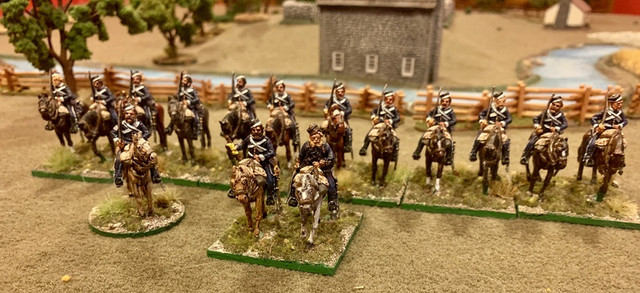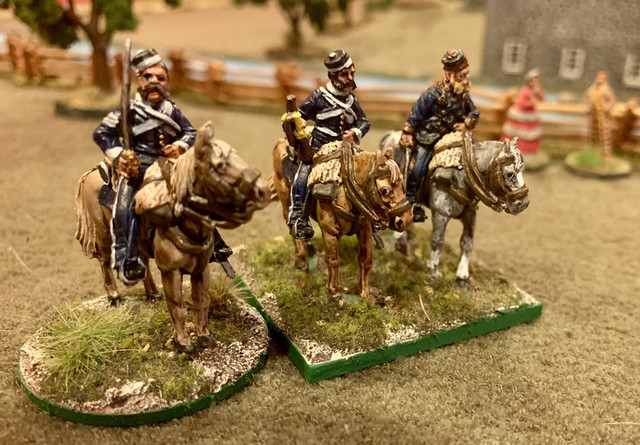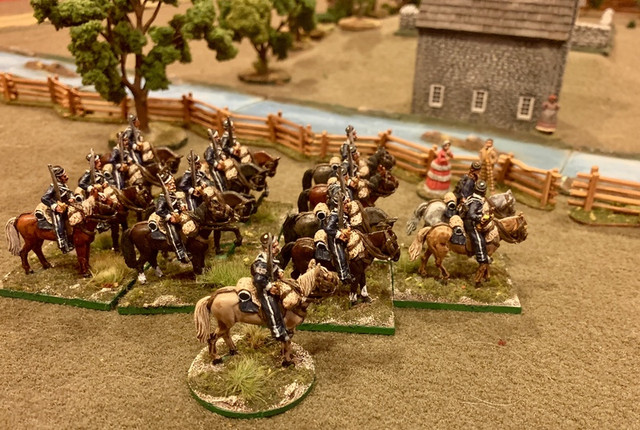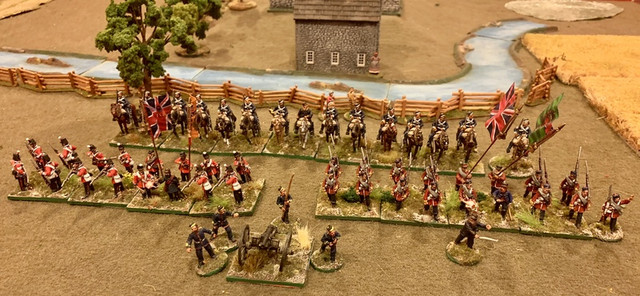With four hours here in Ontario before the old year sees itself out, it seems like a good time to unveil my last completed project of the year. Cracking on with my alt-ACW project, here are Perry Miniatures’ Canadian militia or volunteer cavalry from their British Intervention Force range. The figures are product codes BIF 32 (Command) and BIF 34, standing with shouldered swords and stabled jackets. I don’t know much about the organization and uniforms of the militia cavalry from this period. There are some regiments in the Canadian Reserve Force, like the Governor General’s Horse Guards or the Queens’ York Rangers, that have pedigrees dating back to the War of 1812, but I haven’t found much on their dress. The uniform is my guess from one of the plates in the Osprey Book, Canadian Campaigns 1860-1870 - blue with white piping. I have the figures for another regiment so I may do it in blue with yellow piping, just for contrast.

Sadly they don’t have a guidon bearer, though I have no idea where to source the appropriate flag or whether British cavalry units typically carried flags of any sort. The Sergeant is single based, for use as a leader in Sharpe Practice.

If they were anything like most Canadian militia units of the period, these fellows would most likely be gentlemen and more prosperous farmers, able to afford the horse and uniforms, hoping to impress the ladies, and probably not trained to anything near a professional standard. Put them in the field against a trained Union cavalry unit of the 1862-63 era, and I think they’d be eaten for lunch. You may have noticed that none of the figures are sculpted with carbines. Again, I have no idea if carbines were issued to British cavalry of the mid-Victorian period, but having seen what Sharp breechloaders can do in my previous post, I would fear for these figures on a battlefield. I suspect they would be employed mostly for scouting and as line of communications troops once the British Army began arriving in Canada en masse.

On weekend training, impressing the locals.

2020 saw me make a decent start on this project. There are at least as many unpainted figures to go as you see here, so that will be a steady focus of 2021, and hopefully some battles to follow.

With that, I bid 2020 a less than fond adieu. Joy and I were blessed with good health, and unlike many, we were fortunate enough to remain mostly sheltered in comfort, wanting for nothing, so we refuse to moan about our lot. I missed friends and gaming in person, and I hope to see some of that resume in 2021. May the New Year treat you and your loved ones more kindly.
Blessings from the Mad Padre’s Painting Chapel.
MP+

Interesting looking figures Mike!
ReplyDeleteThanks so much, Ray, happy new year to you and the Rejects!
DeleteOutstanding looking army!
ReplyDeleteThank you, Mark, it is starting to look like an army!
DeleteGoing to be watching this develop with interest.
ReplyDeleteThanks, I'll be watching it myself! Trying to decide whether I should start putting troops on the table to see what happens. Why not?
DeleteA gallant force assembled, they look great.
ReplyDeleteThanks Alan, they are gallant and dashing fellows indeed.
DeleteExcellent looking minis sir!
ReplyDeleteThanks mate.
DeleteThey do look the part, and would problem wind up picking up a long arms of some kind after they get blooded. But I can see them being a dangerous group of armatures as well, if you can get them to the right place at the right time to charge a exposed flank or some thing.
ReplyDeleteThanks. Trying to turn a flank on a Civil War battlefield was always a dangerous thing for cavalry as it meant a lot of standing around and being vulnerable, but it could happen. Certainly could happen at the skirmish level.
DeleteNice work on the Canuck Cavalry. All the best for 2021.
ReplyDeleteThanks Peter, you too.
DeleteGood figures and good notes! Happy new year!
ReplyDeleteThank you John, the same to you and yours.
DeleteCan't wait to get these splendid fellows on the table with you!
ReplyDeleteNext roto OP TD!
DeleteVery attractive cavalry. My copy of Denison's memoirs has gone walk about (or maybe was passed on as a gift a decade or so back) but its available free as a pdf. Essential reading on the mid 19thC Canadian army.
ReplyDeleteSoldiering in Canada
A very interesting fellow, friends with various American, Confederate and British officers as well as various Canadian politicians and militia officers so lots of little stories.
Anyway, Denison had requested that the repeating Spencer carbines be released from stores and issued to his men and that he be allowed to expand the Bodyguard to a full squadron but was turned down on both accounts so when they marched to meet the Fenians in '66 they were armed with swords and revolvers. (They also had unoffical jack boots with trousers tucked into them (as was becoming the fashion) rather than the authorized overalls but that's trivia.)
In case the link doesn't work: .https://electriccanadian.com/forces/soldieringincanada.pdf
ReplyDeleteSuperbly done! To me, that sergeant look like Windsor Davies in 'It ain't half hot Mum'!
ReplyDeleteRegards, James
interesting..... in the UK the markmanship of Yeomanry units was often significantly better than that of regular troops as they had both the spare time to practice and the spare money to buy expensive equipment to support their hobby. the difference this could make was certainly felt during the Boer war when the regulars of the 22nd Cheshire Regiment were joined by a Yeomanry unit who had honed their long distance shooting on Southport Beach. From being able to pick off regular troops with impunity from afar, Boer snipers suddenly found themselves it in their opponents' crosshairs for a change and from a distance at which they were incapable of returning fire. The ability of the Boer troops to impede British movement was considerably reduced from that point on in the campaign.... and is remembered with fondness by the regiment to this day
ReplyDeleteIn the 1860's, once the Trent thing wad settled, the govt didn't take the threat of invasion seriously so were reluctant to spend money on the militia. The Fenians changed and they began releasing upto date weapons. At Ridgeway the Canadians held their own against the ACW veterans until ammo fell short and training fell short with it. It was the last even partially successful raid. The Canadian volunteers in the Boer War also held their own when facing the Boers.
Delete